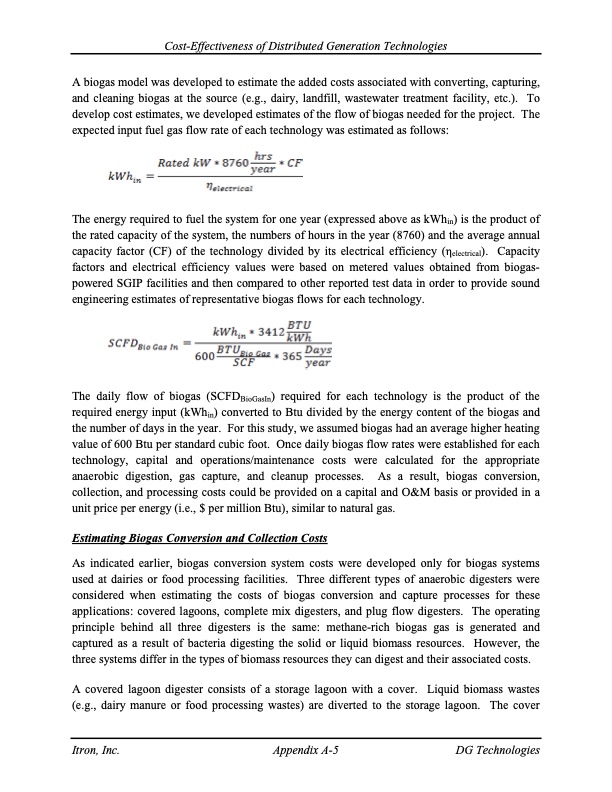
PDF Publication Title:
Text from PDF Page: 146
Cost-Effectiveness of Distributed Generation Technologies A biogas model was developed to estimate the added costs associated with converting, capturing, and cleaning biogas at the source (e.g., dairy, landfill, wastewater treatment facility, etc.). To develop cost estimates, we developed estimates of the flow of biogas needed for the project. The expected input fuel gas flow rate of each technology was estimated as follows: The energy required to fuel the system for one year (expressed above as kWhin) is the product of the rated capacity of the system, the numbers of hours in the year (8760) and the average annual capacity factor (CF) of the technology divided by its electrical efficiency (ηelectrical). Capacity factors and electrical efficiency values were based on metered values obtained from biogas- powered SGIP facilities and then compared to other reported test data in order to provide sound engineering estimates of representative biogas flows for each technology. The daily flow of biogas (SCFDBioGasIn) required for each technology is the product of the required energy input (kWhin) converted to Btu divided by the energy content of the biogas and the number of days in the year. For this study, we assumed biogas had an average higher heating value of 600 Btu per standard cubic foot. Once daily biogas flow rates were established for each technology, capital and operations/maintenance costs were calculated for the appropriate anaerobic digestion, gas capture, and cleanup processes. As a result, biogas conversion, collection, and processing costs could be provided on a capital and O&M basis or provided in a unit price per energy (i.e., $ per million Btu), similar to natural gas. Estimating Biogas Conversion and Collection Costs As indicated earlier, biogas conversion system costs were developed only for biogas systems used at dairies or food processing facilities. Three different types of anaerobic digesters were considered when estimating the costs of biogas conversion and capture processes for these applications: covered lagoons, complete mix digesters, and plug flow digesters. The operating principle behind all three digesters is the same: methane-rich biogas gas is generated and captured as a result of bacteria digesting the solid or liquid biomass resources. However, the three systems differ in the types of biomass resources they can digest and their associated costs. A covered lagoon digester consists of a storage lagoon with a cover. Liquid biomass wastes (e.g., dairy manure or food processing wastes) are diverted to the storage lagoon. The cover Itron, Inc. Appendix A-5 DG TechnologiesPDF Image | Cost-Effectiveness of Distributed Generation Technologies

PDF Search Title:
Cost-Effectiveness of Distributed Generation TechnologiesOriginal File Name Searched:
SGIP_CE_Report_Final.pdfDIY PDF Search: Google It | Yahoo | Bing
NFT (Non Fungible Token): Buy our tech, design, development or system NFT and become part of our tech NFT network... More Info
IT XR Project Redstone NFT Available for Sale: NFT for high tech turbine design with one part 3D printed counter-rotating energy turbine. Be part of the future with this NFT. Can be bought and sold but only one design NFT exists. Royalties go to the developer (Infinity) to keep enhancing design and applications... More Info
Infinity Turbine IT XR Project Redstone Design: NFT for sale... NFT for high tech turbine design with one part 3D printed counter-rotating energy turbine. Includes all rights to this turbine design, including license for Fluid Handling Block I and II for the turbine assembly and housing. The NFT includes the blueprints (cad/cam), revenue streams, and all future development of the IT XR Project Redstone... More Info
Infinity Turbine ROT Radial Outflow Turbine 24 Design and Worldwide Rights: NFT for sale... NFT for the ROT 24 energy turbine. Be part of the future with this NFT. This design can be bought and sold but only one design NFT exists. You may manufacture the unit, or get the revenues from its sale from Infinity Turbine. Royalties go to the developer (Infinity) to keep enhancing design and applications... More Info
Infinity Supercritical CO2 10 Liter Extractor Design and Worldwide Rights: The Infinity Supercritical 10L CO2 extractor is for botanical oil extraction, which is rich in terpenes and can produce shelf ready full spectrum oil. With over 5 years of development, this industry leader mature extractor machine has been sold since 2015 and is part of many profitable businesses. The process can also be used for electrowinning, e-waste recycling, and lithium battery recycling, gold mining electronic wastes, precious metals. CO2 can also be used in a reverse fuel cell with nafion to make a gas-to-liquids fuel, such as methanol, ethanol and butanol or ethylene. Supercritical CO2 has also been used for treating nafion to make it more effective catalyst. This NFT is for the purchase of worldwide rights which includes the design. More Info
NFT (Non Fungible Token): Buy our tech, design, development or system NFT and become part of our tech NFT network... More Info
Infinity Turbine Products: Special for this month, any plans are $10,000 for complete Cad/Cam blueprints. License is for one build. Try before you buy a production license. May pay by Bitcoin or other Crypto. Products Page... More Info
| CONTACT TEL: 608-238-6001 Email: greg@infinityturbine.com | RSS | AMP |